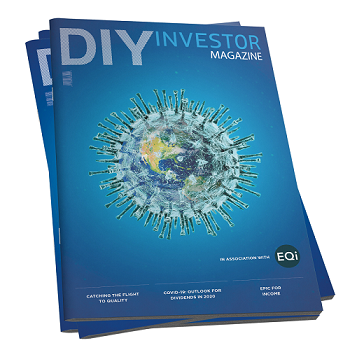Investing Basics: What is a P/E ratio and how to use it to create a fair value calculation for shares?
With all the caveats, P/E is likely to remain near the top of the list of commonly used valuation measures for shares in a wide range of, though not all sectors. It embraces complex considerations within a simple formula. It has an intuitive validity which is borne out by much more complex analysis, but is universally understood.’ writes Christian Leeming
What is a P/E ratio?
Price to earnings ratio (P/E) is a statistic widely used to measure or value a company’s shares. A high P/E commonly indicates an expectation of significant profit growth. P/E is calculated by price per share divided by the company’s profits over its weighted average number of shares in issue, or earnings per share (EPS).
Investors use P/E comparisons between peers to determine the attractiveness of an investment case. If a company has a higher than average P/E compared to peers with similar growth rates, it indicates investors’ confidence in its prospects compared to rivals.
How can dividends change investors’ perception of P/E?
In theory, faster-growing companies should have higher P/Es than mature firms with slower growth prospects. Mature companies can have lower growth potential, which will be reflected by a lower P/E.
In general, investors must choose to what extent they want a return on investment from dividends or the sale of shares after capital growth. In larger companies with traditionally lower P/Es, a higher percentage of the company’s earnings may be used to repay its investors through dividends.
Conversely, dividends may be small or non-existent in fast-growing companies as investors are willing to pay more for the expected growth in earnings and cash flow, and the consequent upside when they resell their shares when these growth expectations have been fulfilled.
That said, investors must be wary if dividends are unusually high compared to price, in the form of dividend yield, or earnings as a pay-out ratio. A high dividend yield or pay-out ratio may be a sign that the company’s earnings are either volatile or cyclical, leading to inconsistent dividends.
In addition, investors favouring dividends can explore cash-generative companies in mature and stable industries. Mature firms will not necessarily need to reinvest as much for future growth, so are more likely to use their cash to repay investors in the form of dividends.
How can P/E be used instead of complex valuation models?
Analysts have varying preferences as to what type of future cash flow valuation is optimal for determining present value. Among these, the dividend discount model (DDM) values a company based on future dividend payments and the discount cash flow model (DCF) values a company based on forecast cash flows.
Nonetheless, valuation models are mathematically equivalent, meaning that if the raw information used as inputs were consistent, every valuation would be the same. In other words, different valuation models, in theory, represent different ways of formatting raw information to arrive at the same value.
Therefore, P/E valuations should produce the same results as DDM, DCF and other methods. As a result, analysts can theoretically capture the value of a security with a P/E alone.
How is P/E used to create a fair value calculation?
Fair value is a result of a valuation model that discounts profits or cashflows to shareholders at an appropriate discount rate and is represented as a share price, which reflects the risk of investment.
One approach to finding fair value, typically used in cyclical sectors, is to create a picture of trend earnings taken from either historic values, a trailing P/E, or from predicted values, a forward P/E. Trend earnings are then multiplied by average P/E to create fair value.
As fair value calculations use either future profits or cashflows to shareholders rather than historical business costs, the subsequent valuation is more relevant for analysts predicting a stock’s value.
What are the limitations of P/E?
Macroeconomic forecasts can distort P/E, as investors’ uncertainty over inflation or interest rates can cause them to change the structure of their portfolio. When inflation or interest rates rise, the discount rate for company cashflows increases. As a result, a company’s valuation decreases, lowering its fair P/E.
Drops in market confidence drive share prices down but are not reflected in the underlying earnings of the company. This can create an inaccurate picture or undervaluation of the company’s prospects.
P/E figures also do not reliably represent a shareholder’s expected return on investment, where a company with a low P/E may be able to provide investors with more consistent and greater dividends than a company with a high P/E. Investors use dividends and book value as a check against this limitation.
P/E can also be influenced by accounting policies for non-cash items such as depreciation and amortisation. It is therefore important to ensure the necessary adjustments are consistent when comparing companies on a P/E basis.
Finally, when comparing figures internationally, it is important to note that differences in accounting standards can result in an artificially high P/E, where, for example, it is advantageous for a company to report lower net income for tax reasons.
Click here to visit DIY Investor

Read the latest edition of DIY Investor Magazine
DIY Investor Magazine
The views and opinions expressed by the author, DIY Investor Magazine or associated third parties may not necessarily represent views expressed or reflected by EQi.
The content in DIY Investor Magazine is non-partisan and we receive no commissions or incentives from anything featured in the magazine.
The value of investments can fall as well as rise and any income from them is not guaranteed and you may get back less than you invested. Past performance is not a guide to future performance.
DIY Investor Magazine delivers education and information, it does not offer advice. Copyright© DIY Investor (2016) Ltd, Registered in England and Wales. No. 9978366 Registered office: Mill Barn, Mill Lane, Chiddingstone, Kent TN8 7AA.
